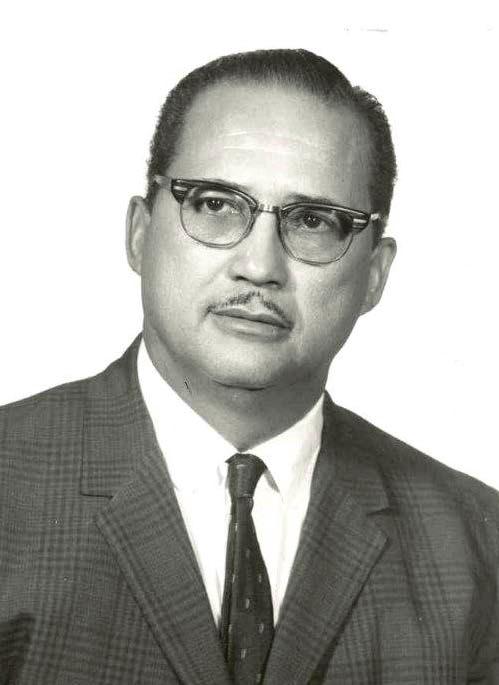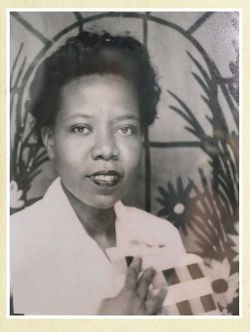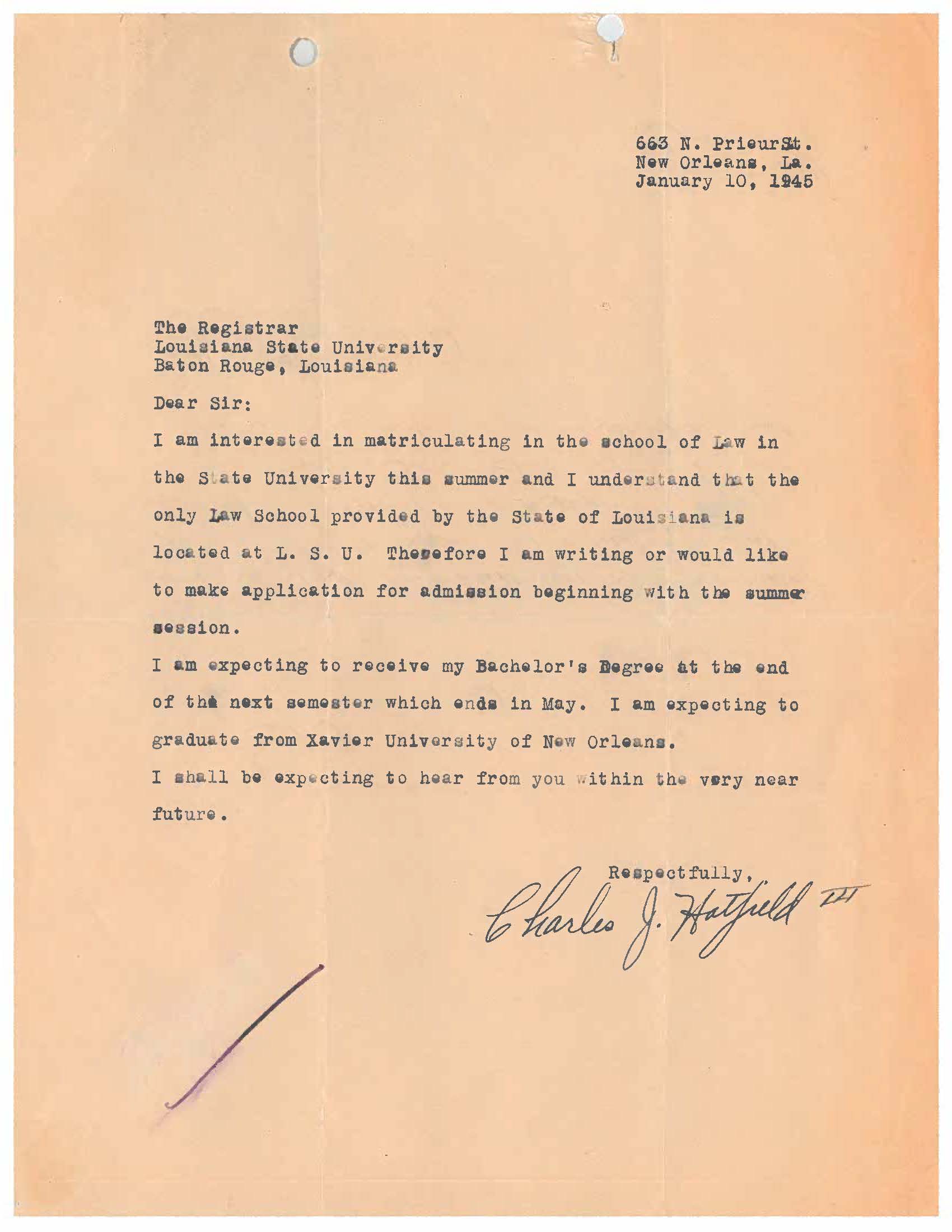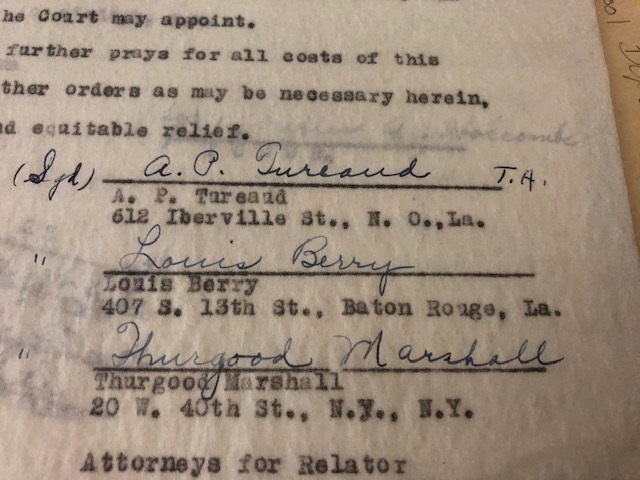Prelude to Civil Rights: Viola Johnson and Charles Hatfield
Prior to the celebrated Baton Rouge Bus Boycott, the shared wounds of inequity and discrimination had marshaled other preludes to the Civil Rights Movement in the capital region. As early as the 1940s, Black community leaders, veterans, and students in greater Baton Rouge had mobilized to promote the issues of improving voter registration, equalizing teacher compensation, and integrating public schools. A full decade before some of the most influential social justice action in Montgomery, Atlanta, and Little Rock, Louisiana had Viola Johnson and Charles Hatfield, two Black college students who assumed the mantle and propelled the pursuit of equality in America.
Charles Hatfield
On January 3, 1946, Charles Hatfield, a Black WWII Army Veteran and graduate of Xavier University in New Orleans, wrote to LSU seeking admittance to the state’s only public law program, arguing that since Louisiana had no law school for people of color, he should be allowed to attend the one at Baton Rouge. Two weeks later, law school Dean Paul Hebert wrote back to Hatfield to reject the application, underscoring LSU’s observance of the state’s segregation laws as the basis for the decision. (During this saga, Dean Hebert was nearing his sabbatical to serve as a judge in the Nuremberg Trials which would strike the precedent that nations and states could be punished for violating the rights of their own citizens.)
In the January 24 rejection letter, Hebert admonished Hatfield to apply to Southern University, despite that institution having no law school. A month later Hatfield, having become aware that the NAACP had taken plaintiffs in other states who had been denied acceptance to public universities, retained NAACP representation to file suit. A.P. Tureaud and Joseph A. Thornton, lawyers for the New Orleans chapter of the NAACP, alleged that the state’s flagship, all-white university had violated Hatfield’s fourteenth amendment rights.
Viola Johnson
In June of that same year, only six months after Hatfield’s initial rejection, Viola Johnson, a Black graduate of Southern University (then Southern Negro University) applied to LSU’s medical school in New Orleans. Similarly, Southern University did not have any such program. Johnson had been part of a coalition of young activists who had been working with the NAACP to challenge white universities with admissions cases and she was prepared to take action. The team expected Johnson’s rejection from LSU and she joined the suit alongside Hatfield. With future Supreme Court Justice Thurgood Marshall, Robert Carter, and Louis Berry representing them, Johnson and Hatfield brought their suit to the Baton Rouge District Court. Whereas the team had predicted the state might duck Hatfield’s admission to the law program at LSU due to the state’s ability to fund a separate law school at Southern, they weren’t convinced that Louisiana could support separate medical schools. Louisiana, along with other southern states, were taking their cues from little-known United States Supreme Court case Gaines v. Canada in which the court ruled that any state wanting to provide a school to white students also had to provide in-state education to Black students. A law school was costly, but to allocate monies for a separate medical school was inconceivable. Louisiana’s only maneuver to reject Johnson’s admission would be to fund her tuition at an out-of-state school—hardly an equal move in the eyes of the NAACP legal team.
University Response
The fact was not lost on university administrators that the suit had the prospect of ending segregation in public schools. (This almost a decade before the watershed Brown v. Board of Education of Topeka case in 1954.) In a 1947 letter to acting LSU president Fred Frey, Dean Hebert explained his apprehension for putting LSU at the center of a landmark court decision, cautioning that the school “should keep clearly in mind that if this case is taken to the United States Supreme Court, it might possibly become the vehicle for the repudiation of the South’s policy of racial segregation in educational institutions.” Before integration, southern states created a multitude of obstructions to keep Black applicants from even applying to white public universities. Some state legislatures, like in Louisiana, allocated resources to fund modest out-of-state scholarships for Black students, thereby obviating the need to accommodate those students in-state. In the case of Hatfield, the legislature believed the only way to keep him out of the LSU law program was to create one at Southern University.
State leaders tried to pressure Southern President Felton G. Clark to compel Hatfield into dropping the suit, but Clark refused and leveraged the state’s need to establish the new law school. Clark was already steering Southern through a massive expansion and he emphatically rejected any half measures for the new law school. Clark, knowing the Gaines decision would provide the baseline for a law school, anticipated that Louisiana was likely to imperil the future of Southern Law by underfunding its establishment. When the legislature tried to shortchange the program, Clark disputed the assessment and negotiated the legislature to more than double the funding. This ensured that Clark could provide robust resources for the new law library, a guaranteed accreditation-worthy educational program, and a distinguished law faculty that he himself would select. This faculty would include Southern’s first law dean, A.A. Lenoir, whose philosophy was that only by increasing the number of Black lawyers would Black citizens achieve racial equality and social justice in America.
Fate of the Case
Hatfield’s portion of the case was dismissed in district court in April 1947 when the Gaines decision resulted in the establishment of Southern’s law program, but the chances of Johnson’s portion going to the Supreme Court looked promising due to the state’s incapacity to finance two public medical schools. LSU administrators understood the situation was inescapable, yet continued to prolong the process. In a 1947 memo, Dean Hebert urged President Frey to think about “whether it is wise to jeopardize the policy of racial segregation in its broader applications by fighting the Johnson case.” The Law School Dean concluded that the university’s role in such matters should be complementary to a specialized commission of the Board of Supervisors, State Superintendent of Education, Louisiana Attorney General, and the Office of the Governor. Viola Johnson, weary from being embogged in bureaucracy, reluctantly accepted an out-of-state scholarship to finish her medical training.

Personal and Historical Impacts
Locally the case was met with such anger and contempt that Hatfield decided to leave Louisiana in order to escape death threats and other acts of intimidation. He settled in Atlanta and earned his master’s degree in sociology. He remained a community leader and social activist throughout his life.
Johnson was awarded an out-of-state scholarship to attend Meharry Medical College in Tennessee, in accordance with the state’s segregationist policies. By the time her case made it to the Louisiana Supreme Court, she was already living in Texas because, like Hatfield, she had received numerous death threats as the case wound its way through the courts, and further had been refused business loans for establishing her medical practice in Louisiana. The state dismissed the case due Johnson’s out-of-state residency, which they themselves actuated. After finishing medical school, Johnson moved to Fort Worth and then to Midland where she held a private practice for over fifty years, breaking down many racial barriers in West Texas.

The Johnson and Hatfield cases inspired other NAACP lawyers in the South to pursue similar litigation in the late 1940s and early 1950s. Because of the groundwork laid by Johnson and Hatfield, Civil Rights cases gained immediate traction in federal courts. A 1950 Texas ruling in Sweatt v. Painter, litigated by NAACP lawyers well-versed in the Hatfield and Johnson strategy, led to the decision that a person cannot be denied acceptance into a state university law program on the basis of race.
The very next year, A.P. Tureaud, Louis Berry, and Thurgood Marshall took another plaintiff in Louisiana: Ernest “Dutch” Morial. Morial would become the first Black graduate of LSU Law and the first Black mayor of the City of New Orleans—an unlikely story without the contributions of Johnson and Hatfield.
While successive appeals to their own cases were ultimately blocked by the cruelty of the Jim Crow legal system, Viola Johnson and Charles Hatfield’s resolve in the face of intimidation, harassment, and victimization accelerated the shifting definition of what it meant to be equal in America.
References
Board of Supervisors Records, RG#A0003, Report of a Meeting Representatives of LSU and Representatives of the State Board of Education held at the Louisiana State Capitol on 12 August 1946, Box 7 Folder 310. Louisiana State University Archives, LSU Libraries, Baton Rouge, Louisiana.
Board of Supervisors Records, RG#A0003, Suits Against the University: Charles Hatfield, Box 8 Folder 47. Louisiana State University Archives, LSU Libraries, Baton Rouge, Louisiana.
Board of Supervisors Records, RG#A0003, Suits Against the University: Viola Johnson, Box 8 Folder 46. Louisiana State University Archives, LSU Libraries, Baton Rouge, Louisiana.
Emanuel, Rachel L.., Ball, Carla. Southern University Law Center. United States: Arcadia Publishing, 2018.
Hebert, Mary Jacqueline, “Beyond Black and White: the Civil Rights Movement in Baton Rouge, Louisiana, 1945--1972,” PhD diss., (Louisiana State University and Agricultural and Mechanical College, 1999).
“Law School at Southern U. Faces Inspection for Accreditation Soon.” State Times Advocate (Baton Rouge, Louisiana), May 30, 1949: 6.
Patterson, Jimmy. “Letters Found in South Midland Home Tell Story of Viola Coleman's Significant Role in Civil Rights.” Midland Reporter-Telegram (Midland, TX), May 3, 2008.
Sinegal-DeCuir, Sharlene. “Opening the Doors: The struggle to desegregate LSU Law School,” Around the Bar, no. 314 (February 2017): 10-12.
Further Research
Viola Johnson (Coleman)’s letters are at The University of Texas Permian Basin in Odessa.
Charles Hatfield’s papers are at the Amistad Research Center in New Orleans.



